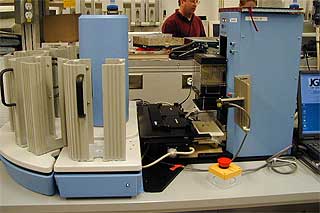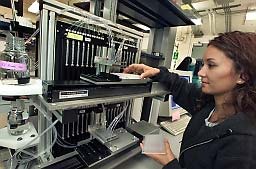
The Robbins Twister robot transfers samples from RCA reaction plates.
Only 1 µl from the RCA reaction plate is transferred to a new 384-well plate using the Robbins Twister robot.
Next, 9 µl of ET terminator sequencing mix is dispensed onto the same plate using the Cavro Dispensing Robot.

Cavro Dispensing Robot
The ET terminator sequencing mix contains
- dNTPs (the four nucleotides, A, C, G, and T)
- ddNTPs (dNTPs with a colored fluorescent dye added to each base). Sequencing terminates when the polymerase runs into a ddNTP.
- one primer (which targets only the insert). Only one side of the DNA strand is going to be sequenced.
- polymerase (which adds dNTPs to a strand of DNA)
The plate with the chemicals for the sequencing reaction is loaded onto a thermal cycler, which goes through a three-part heating cycle 30 times. In each cycle, the DNA is “unzipped” (denaturation, 1 minute at 94°C), the primers attach to one strand of the DNA (annealing, 15 seconds at 50°C), and then the primer sequence is extended by adding dNTPs (elongation, 4 minutes at 60°C) that complement the sequence on that strand. Because all four normal nucleotides are present, chain elongation proceeds normally until, by chance, DNA polymerase inserts a fluorescently tagged ddNTP instead of the normal dNTP. This halts the elongation process, leaving a DNA sequence that ends with one of the four colored ddNTPs.